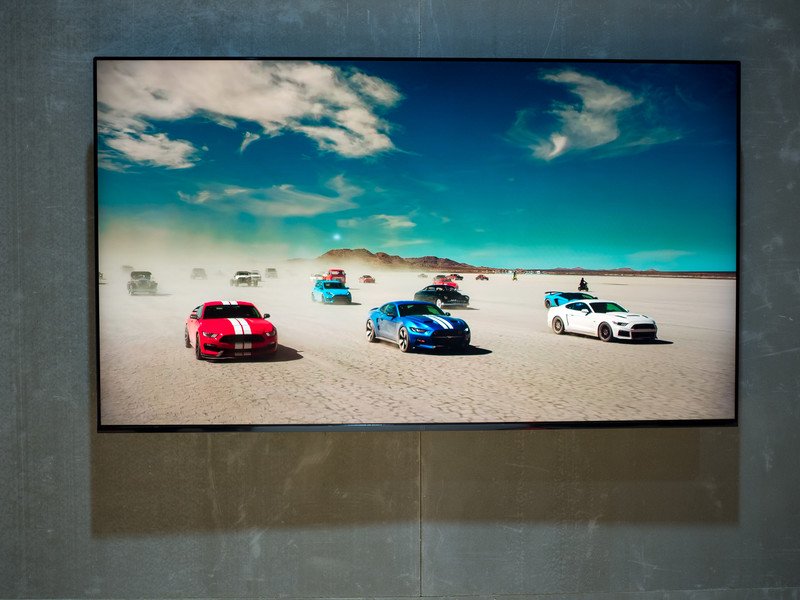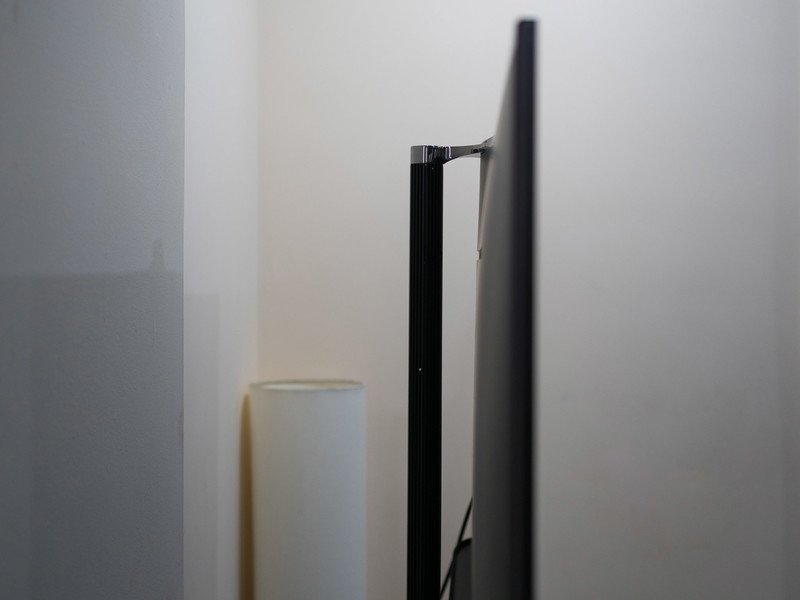
OnePlus knows how to make a good phone, and while the company has dabbled in accessories over the last three years, it hasn't ventured into other product areas. That's changing now as the manufacturer makes its foray into the TV segment, joining a long list of tech brands that have turned their attention to this category in recent years.
OnePlus sees this segment as one that has a lot of potential for growth in the coming years, with the brand noting that the TV will transform from being another screen to the center of your connected home. Like its phones, OnePlus is positioning its TV in the premium category, with the company touting picture and sound quality on par with the best in the industry. That means Samsung and LG, and in typical OnePlus fashion, it is looking to undercut both brands.
The OnePlus TV is launching in India first, with global availability slated for later in the year. India is an obvious launch market for OnePlus: it accounts for well over a third of the brand's global sales, and the brand has considerable pull in the country, allowing it to strike content partnerships with local streaming players. That's a big deal for a new player in this industry, as we shall see later. Let's see what the OnePlus TV has to offer.

Time to settle
Great QLED panel, but it just isn't worth it.
The OnePlus TV has a 4K QLED panel that holds up very well, and the built-in soundbar has excellent sound quality. But the design with the slide-out soundbar and chrome base hearken back to the '90s, and the remote is just not usable. For what it costs, there are plenty of better alternatives available from Samsung and LG.
Pros
- Vibrant 4K QLED panel with great colors
- Integrated soundbar has excellent sound
- OnePlus Connect works very well
- Android TV with three years of updates
Cons
- No Netflix out of the box
- Worst remote you'll find on any TV today
- Garish design with chrome accents
- Wobbles if you look at it wrong
- Costly for what you get
OnePlus Q1 Pro TV What looks great

OnePlus is launching two TV models in India: Q1, and Q1 Pro. Both have the same 55-inch 4K QLED panel and share most of the same features, with the only difference being the soundbar. The Q1 Pro has an integrated soundbar with eight drivers that delivers a 50W sound, and the Q1 has a four-driver design that also produces 50W of sound. In all other areas, the two models are identical.
The OnePlus TV has a sleek design with minimal bezels, and there's a spine running up the back — OnePlus says it got the inspiration from Greek architecture — that holds the panel in place. The base is finished in chrome, and the back has a carbon fiber finish that's identical to OnePlus' phone cases. The soundbar is hidden behind the panel when not in use, and it slides out as soon as you switch the TV on. Oh, and there's a "horizon light" embedded in the ridges of the soundbar that activates whenever it's sliding out, with OnePlus noting that it wanted to make switching on the TV a momentous occasion every time.






There are four HDMI ports at the back (with a single ARC), one USB 3.0 port, one USB 2.0 port, Ethernet, optical out, and analog audio. The soundbar is encased in a mesh fabric, and that provides a nice contrast to the chrome and carbon fiber that's featured elsewhere. OnePlus went with Android TV as the platform of choice, and it has a few features of its own in the form of OxygenPlay and OnePlus Connect. But more on that later.
The highlight of the OnePlus TV is the 4K QLED panel. Think of QLED as a turbocharged version of LCD: you still get an LCD display with LED backlighting, but there is a quantum dot layer embedded in the middle that enhances colors and brightness. The LED light is transmitted through several layers — making it a transmissive panel — and while you don't get the same inky blacks as an OLED TV, modern QLED TVs come pretty close.
A fantastic QLED panel that's better than other TVs in this segment, but it isn't quite on par with Samsung or LG.
I watched a lot of rugby and Formula 1 on the OnePlus TV, and it looked fantastic. The panel has vibrant colors with great contrast levels and brightness, and HDR content, in particular, stands out — it works with HDR10+ as well as Dolby Vision. Like most major TV manufacturers, OnePlus relies on motion interpolation — or MEMC (Motion Estimation, Motion Compensation) — to deliver smooth visuals. If you've picked up a new TV in recent years and noticed a "soap opera effect" when watching TV shows or movies — where the content feels too lifelike — it's because of motion smoothing.
Most content today is shot at 24fps, but it isn't ideal for sports as that leads to motion blur. With modern TVs featuring a refresh rate of 120Hz or above, TV manufacturers have turned to motion smoothing, essentially adding a frame in between every other frame to smooth out the motion. While it's great for sports, it creates an eerily-smooth quality to movies and TV shows. Thankfully, the OnePlus TV lets you switch off motion smoothing by changing picture modes. All you need to do is enable the Cinema Home mode, and motion interpolation is turned off.

There are 11 picture modes in total, and you also get a lot of customization options that give you fine-tuned control over the picture quality. You have the ability to adjust the contrast and local dimming, noise reduction, gradation, and color balance. In my use case, I found that the image quality looked best with all the effects turned off. That's how I watched The Grand Tour and a host of other shows on Prime Video, and it was an absolute delight. The TV also has a gaming mode that turns off motion smoothing and boosts brightness.
Picture quality is just one half of the equation, however, and the OnePlus TV also excels at audio. There are eight drivers in the soundbar — two full-range speakers joined by two woofers and two tweeters — and the sound quality is fantastic for integrated audio. There's also a nifty feature that automatically lowers the TV volume for incoming calls. You can also use the soundbar as a Bluetooth speaker in Bluetooth Stereo mode, with the screen acting as a giant visualizer.
As the OnePlus TV has a QLED panel, the image quality is much better than what you get on budget TVs from the likes of Xiaomi and Vu. OnePlus is sourcing the panel directly from Samsung — as the QLED label suggests — but it's clear that the panel isn't the best that Samsung has to offer. In a side-by-side viewing test, the OnePlus TV lost out at both color accuracy and viewing angles to Samsung's 2019 QLED TV, so we'll have to once again use the caveat that has followed OnePlus from the very beginning — it's great, but only for its asking price. If you want the absolute best, you're still better off picking up a Samsung or one of LG's OLED TVs.

OnePlus' differentiation for the TV comes by way of OxygenPlay. Essentially, it is a content aggregator that pulls movies and TV shows from multiple streaming platforms. In India, OnePlus is offering recommendations from YouTube, Prime Video, Eros Now, Hungama, Jio Cinema, and Zee 5. OxygenPlay lets you search titles on all aforementioned platforms from a single location.
OnePlus is also introducing a seamless way to connect your phone to the TV. You'll be able to do so via the OnePlus Connect app, which is now available on the Play Store. It works a lot like Android TV Remote, but has a few extra features. The app works on all Android phones — not just OnePlus devices — and offers an easy way to browse media recommendations or cast local content from your phone to the TV. Oh, and you'll be able to take a screenshot of whatever's playing on your TV.
OnePlus Q1 Pro TV What looks off

The OnePlus TV gets a lot right, but where everything falls apart is the remote. Simply put, this is the worst remote I have ever used, and I have no idea how it made its way past usability testing. Let's start with the buttons: there's the usual back, home, and menu buttons along with a trackpad up top, and you get buttons for invoking Google Assistant and launching Prime Video.


You don't get the traditional volume control buttons on the remote; instead, there's a phone-style volume rocker on the side. This is arguably the low point in the remote's design, and that isn't really saying much. Because of the slim profile, you can't change the volume without readjusting your grip on the remote, and something that's as basic as adjusting the volume on your TV ends up being an infuriating experience on the OnePlus TV.
The OnePlus TV remote sacrifices usability for a clean aesthetic, and is just plain bad.
I'm not exaggerating here; I looked at all the remotes I have lying around in the house — from Sony, Xiaomi, NVIDIA, Polk, Logitech, and Amazon — and while Sony continues to put more buttons than you'd ever end up using, there isn't a remote that is quite as bad as the OnePlus TV remote in terms of usability.
Even Logitech's tiny remote for the Z906 has a volume button that is easier to use than the OnePlus TV remote. Heck, even the Apple TV remote — the "inspiration" for OnePlus — does a better job in this regard. But it's all worth it because there's a USB-C port at the bottom for when you need to charge the remote, something you'll do once every three months.
There's no Netflix app on the OnePlus TV, but the company says it's coming soon.
On the subject of buttons, there is one that's missing here: Netflix. The streaming service isn't available on the TV at launch, and OnePlus says it is working on adding the service before the end of the year. There's only one problem with that, however: Netflix mandates a physical button on the remote for all certified TVs, so I'm not entirely sure how OnePlus will get around that particular problem. And judging by how long it took Xiaomi to get Netflix onto its Mi TV platform, it'll likely be a long wait.
Then there's the design of the TV itself. OnePlus is usually pretty great at product design — just look at the OnePlus 7T — but with the TV, it has failed magnificently. The chrome base, slide-out soundbar, and garish design at the back just doesn't fit inside a modern living room. Combine that with the aluminum remote, and the aesthetic feels as well-defined as the last season of Games of Thrones . OnePlus says it spent a lot of effort designing the TV, but it should have invested that time into fixing the remote.
Also, you know that there's something fundamentally wrong with the design when the entire frame wobbles. Because the TV has a spine that connects to just two points along the panel, there isn't any rigidity to the structure, and it wobbles to such an extent that I was worried if the base would be able to take the weight of the TV. If you're getting this TV, do yourself a favor and get it mounted on a wall.
Finally, we need to talk about the pricing. Samsung and LG have great options in this category, and the OnePlus TV retailing at ₹99,900 ($1,400) is in roughly the same segment. That's far too much when you consider the panel quality on offer and the fact that the OnePlus TV doesn't quite measure up to what Samsung, LG, and Sony have been doing in this space.
OnePlus Q1 Pro TV Should you buy it?

Overall, the OnePlus TV gets the basics right. The panel is what you care about most on a TV, and in that area, there are zero issues. The 4K QLED panel is fantastic, as is the integrated soundbar.
Same goes for Android TV: you'll get three years of updates, and the interface isn't as cluttered as some of the other players. OnePlus offers decent differentiation in the form of its OxygenPlay and OnePlus Connect, and these utilities will only get better over time as customers start using them and providing feedback.
That said, it isn't without its shortcomings. The design is particular is off-putting, and I'm still not sure how that remote made its way into a consumer product. And when you consider how much it costs, there just isn't a good enough reason to buy the OnePlus TV at this point.
The OnePlus TV is slotting into a category that's very well catered to by the likes of Samsung and LG. Sure, Android TV with three years of updates is good to have, but you'll get much more value for your money by picking up a TV from a more established player. The OnePlus TV just doesn't have what it takes to justify the ₹99,900 ($1,400) figure.

Time to settle
Great QLED panel, but it just isn't worth it.
The OnePlus TV has a 4K QLED panel that holds up very well, and the built-in soundbar has excellent sound quality. But the design with the slide-out soundbar and chrome base hearken back to the '90s, and the remote is just not usable. For what it costs, there are plenty of better alternatives available from Samsung and LG.










